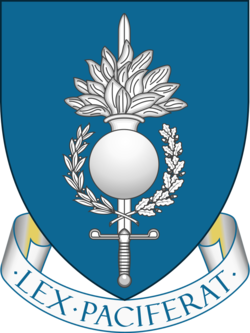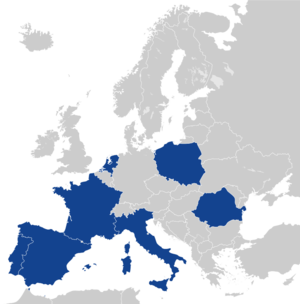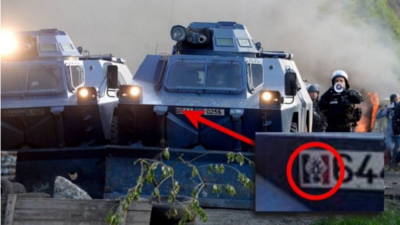European Gendarmerie Force
(Police force, Military organization) | |
|---|---|
 | |
| Motto | Lex paciferat (The law will bring peace) |
| Formation | 2006 |
| Headquarters | Vicenza, Italy |
| Membership | • Gendarmerie nationale • Carabinieri • Guardia Civil • Guarda Nacional Republicana • Koninklijke Marechaussee • Jandarmeria Română • Żandarmeria Wojskowa • Viešojo saugumo tarnyba • Jandarma Genel Komutanlığı |
| An operational, pre-organised, and rapidly deployable EU intervention force with military status - meaning mysterious foreign-speaking troops with no local connections are used to crush unrest. | |
The European Gendarmerie Force (EUROGENDFOR) is an operational, pre-organised, and rapidly deployable intervention force, exclusively comprising elements of several European police forces with military status ("gendarmes"). The force can be put mainly at disposal of the EU, the UN, OSCE, NATO, and other International Organizations or ad hoc coalitions. It is not subject to the law of the country in which it is used.
Contents
Background
EUROGENDFOR was launched by an agreement in 2006 between five member states of the European Union (EU): France, Italy, the Netherlands, Portugal, and Spain. Romania joined in 2009; Poland in 2011.[1] Its status is enshrined in the Treaty of Velsen of 18 October 2007.[2][3]
The headquarters are located in Vicenza, Italy. The choice of Vicenza is significant, as chosen Vicenza as it is also the location of one of the largest US military bases in Europe, indicating that some fort of cooperation in operations is envisaged.
Eurogendfor can count on a force of 900 gendarmes that can be mobilized in thirty days, plus a reserve of another 2,300; all managed by two central bodies, one political and one technical. The first is the high-level interdepartmental committee, called CIMIN, an acronym for Comité InterMInistériel de haut Niveau, made up of representatives of the foreign and defense ministries adhering to the treaty. The other is the Permanent Headquarters (PHQ), made up of around 40 staff.
It is presently not established at the EU level (referred to as the Common Security and Defence Policy, CSDP). It may however contribute in the implementation of the CSDP, when made available as a multinational force in accordance with article 42.3 of the Treaty on European Union (TEU).
The Treaty of Velsen Article 22 gives EUROGENDFOR's properties and funds immunity from executive measures by the judicial authorities of the individual nation states. Article 23 provides that all communications from Eurogendfor officers cannot be intercepted.[4] It is not subject to the law of the country in which it is used.
Own words
EUROGENDFOR is offered as an operational, pre-organised, robust and rapidly deployable asset, able to perform all police tasks. EUROGENDFOR can be put mainly at disposal of the EU, the UN, OSCE, NATO, and other International Organizations or ad hoc coalitions.
EUROGENDFOR will perform police missions with particular regard to substitution. Substitution means that the "Local Police has to be totally replaced because they do not exist or the existing structure is not organised, able or reliable to perform its functions. It will be necessary to re-establish from scratch a new Local Police system," or that "Local Police can be maintained" but "will have to be submitted to vetting and re-training processes and, once new personnel has been recruited and trained, will then progressively take over full responsibility for police functions. The international police presence will have primacy over the Local Police in performing police functions, and will retain the responsibility in carrying out high profile investigations."[5]
Deployment
Although the force is hardly known and hardly mentioned in the corporate media, it already has operational experience: 2007 and 2010 in Bosnia and Herzegovina, 2009 in Afghanistan, 2010 in Haiti, 2014 in the Central African Republic and Mali and 2016 in Ukraine.[6]
Images and films show police units of unknown origin being used against the Yellow Vests in France in 2018. Army vehicles were seen, but regular French soldiers did not appear during the clashes between the security forces and the population - at least not recognizable. But there were armored vehicles with the EU flag on them or foreign insignia, and soldiers in full gear who apparently did not belong to the French police. It looks very much as if EUROGENDFOR was used, because some used Eurogendfor badge with the sword and the motto: "Lex paciferat" (the law will bring peace).[7]
References
- ↑ http://www.zw.wp.mil.pl/en/253.html
- ↑ Eurogendfor.org, Treaty establishing the European Gendarmerie Force Archived 2016-05-18 at the Wayback Machine., accessed on January 24, 2014
- ↑ http://www.fiep.org/wp-content/uploads/2011/12/E-reader-FIEP-Seminarbook.pdf
- ↑ https://eurogendfor.org/wp-content/uploads/2018/10/20071018-treaty.pdf
- ↑ https://eurogendfor.org/egf-capabilities/
- ↑ https://eurogendfor.org/participation/
- ↑ https://www.zaronews.world/zaronews-presseberichte/eurogendfor-die-privatarmee-der-eu-granden-gegen-die-voelker-europas-einsatz-in-frankreich/

